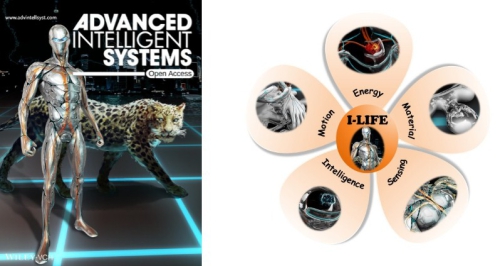Modern robots achieved so far are mainly rigid systems which however often restrict their versatility for more working occasions. For a long time, tremendous efforts have been made among academics and industries to imitate human or more animals’ forms aiming for enrichment of robotic functions. Unfortunately, the usually realized stiff functional elements and their behavior patterns are overall inferior compared with those of animals’ ingenious talents, which are basically a soft entity.
As an alternative, the newly emerging soft robots are being increasingly investigated hoping to significantly simulate advanced characteristics of animals such as the nimble athletic ability, and even acquire versatility for various tasks. However, for most of the advanced soft robots achieved so far, their flexibility, functions, capability etc. are also still far from that the animals could easily offer. Clearly, the big gap existing between idealistic robot and its current reality requests game-changing fundamental theories to be proposed.
Recently, Prof. Jing Liu and co-workers (the first author is Ph.D. student, Tian-Ying Liu) conceive that a most basic restriction of current soft robots may come from the inclusion of intelligent liquid. As is well known, the liquid is a most essential component of natural creatures with profound capacities on assisting homeostatic regulation of physiological functions. However, its participations in more diverse biological behaviors other than that such as intelligence, motion, energy etc. were seriously neglected which however reserved to be undisclosed and would offer pivotal hints to develop ever intelligent machines or soft robots.
In a new article published as cover story (Figure 1) in Advanced Intelligent Systems (T. Y. Liu, P. Qin, J. Liu, Intelligent Liquid Integrated Functional Entity (I‐LIFE): A Basic Way to Innovate Future Advanced Biomimetic Soft Robotics, 2019;https://doi.org/10.1002/aisy.201900017), the authors proposed a basic conjecture that specifically equipping liquid with a robotic system would bring about revolutionary design for future generation advanced soft robots area. Through comparative analogy between artificially made machines and nature created animals, the article drafted a generalized basic methodology which can be termed as Intelligent Liquid Integrated Functional Entity (I-LIFE). The short term I-LIFE as abbreviated here also refers to the ultimate technological goal that the robotic functional components thus realized should behave as close as the capability a living system generally owns. For illustration purpose, the functions of such unconventional robotic liquids were concretely expounded from five aspects as (Figure 1): motion, energy supply, material performance tuning, sensing and intelligence respectively. Typical application examples along these directions were provided and interpreted. A group of intelligent liquids were recommended as candidates for developing future robotic system. Some fundamental scientific and technological challenges lying behind were outlined. Future prospects of I-LIFE were pointed out which would stimulate exciting design of innovative intelligent robotic system. It is expected that the basic principle of robotic I-LIFE system would inspire many worthy directions for future researches in developing ever advanced soft robotics. In other word, the proposition of I-LIFE sowed the seeds for designing many upcoming unconventional soft robots”.

Figure 1 Cover story and typical functions as offered by I-LIFE
T. Liu, P. Qin, J. Liu, Intelligent Liquid Integrated Functional Entity (I‐LIFE): A Basic Way to Innovate Future Advanced Biomimetic Soft Robotics, Advanced Intelligent Systems, 2019
https://onlinelibrary.wiley.com/doi/abs/10.1002/aisy.201900017
NEWS